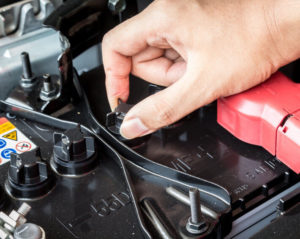A standard 12-volt car battery generates electrical energy or current through the electrochemical reactions that occur inside it. It is this current that starts the car engine when you turn the ignition key. A car battery also acts as a reservoir that stores electrical energy from a car’s generator, If you are interested in what an alternator is, it can help to consider it as a generator that works on the principle of electromagnetism, which produces a current that charges the car battery when the engine is running. The electrical energy stored in the battery powers all the electronics on board your car, including lighting, a stereo system, air conditioning, etc. Therefore, the cycle goes as follows: a charged battery is used to start the engine, and a running engine is used to start the generator, which again charges the battery. Returning to our topic, the reversible chemical reaction between the three main components of the battery, namely lead (Pb), lead oxide (PbO2) and sulfuric acid (H2SO4), allows the car battery not only to produce electricity, but also to store it in the form of charged elements inside batteriesThe element is a battery housing that contains two types of metal plates and two terminals (i.e. positive and negative). One plate is coated with lead and the other is lead oxide. Soak all the cells in the battery (six cells in a 12-volt battery) in 65% water and 35% sulfuric acid in an overall chemical bath called an electrolyte. Chemical reactions between two metal plates in an acidic environment produce electrons that form an electric charge, Charged particles move from the positive end of the cell to the negative end. The same reaction takes place in each cell, and the common electrolyte in the battery transfers electric charge from one cell to another, ultimately leading to the transfer of charge from the positive terminal of the first cell to the negative terminal of the last cell. Each cell produces 2 volts of electricity, and together 6 cells generate 12 volts. It should be noted that the positive terminal of the first element is the positive terminal of the battery, and the negative terminal of the last element is the negative terminal of the battery. The flow of electric charge from the positive terminal of the battery to the negative terminal feeds any circuit connected between the two ends. All electrical systems in the car are directly connected to the circuit between the two terminals of the battery and receive electrical energy through this process. Using an electric charge discharges the battery or discharges it. But then the generator takes over. The engine of a working car feeds the alternator, which generates an electric charge (electrons), and directs it through the negative terminal of the battery to the side of the positive terminal. Thus, the electrons move back into the system, reversing the chemical reactions in the battery and restoring the chemicals to their normal state. Consequently, the battery is replenished and again ready for a 12-volt charge.
-Jack Wilson


